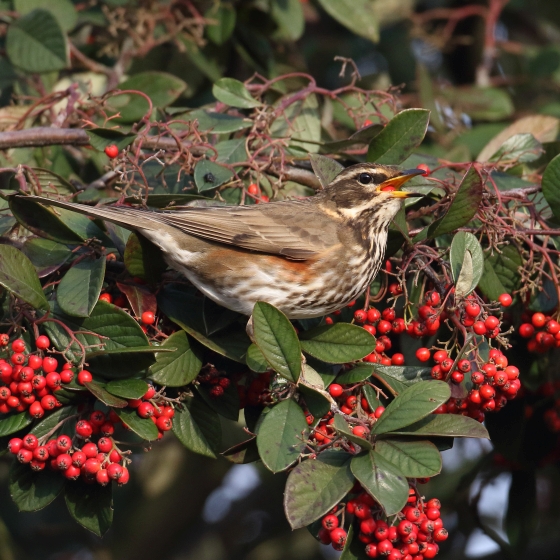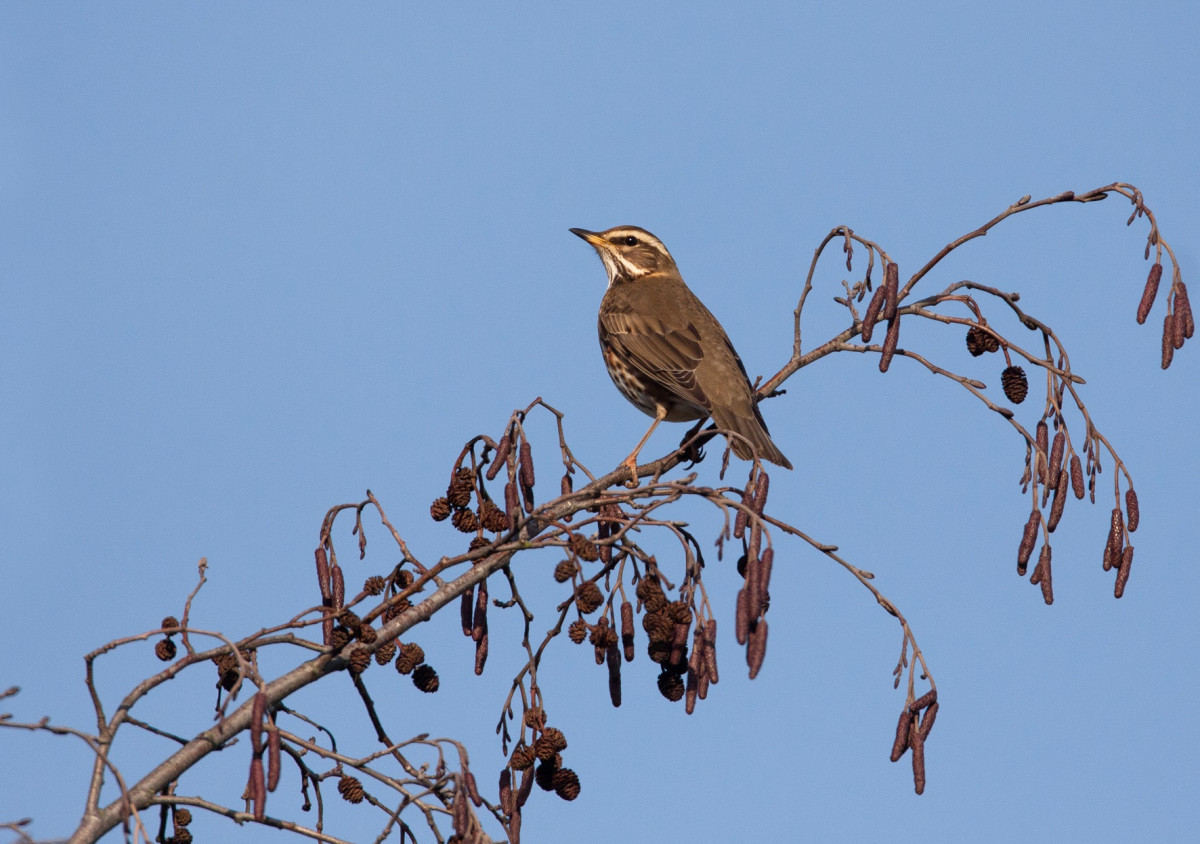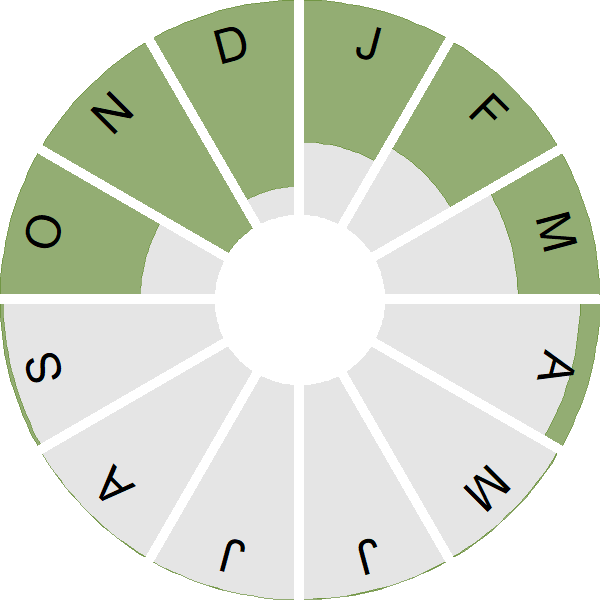Redwing

Introduction
One of the 'winter thrushes', the Song Thrush-like Redwings begin arriving in Britain & Ireland during the latter half of September, before leaving again by mid April.
It is estimated that around 700,000 Redwings winter in the UK, although numbers can fluctuate sharply between years. Redwings come in search of berries, and, when crops fail in northern and eastern Europe, large numbers cross the North Sea. A small number of Redwings also breed in the UK, but only in the far north of Scotland.
During the early winter the Redwing is very much a bird of open country but during freezing conditions Redwings can often be seen in parks and gardens. With birds arriving from both Iceland and Fennoscandia, Redwings can be found across Britain & Ireland during the winter months.

Key Stats
Identification
ID Videos
This section features BTO training videos headlining this species, or featuring it as a potential confusion species.
Redwing and Fieldfare
#BirdSongBasics: Redwing and Fieldfare
GBW: Redwing and Fieldfare
Songs and Calls
Song:
Call:
Flight call:
Status and Trends
Conservation Status
Population Change
Most Redwing seen in the UK are present for the winter only and return to Scandinavia and Iceland to breed. However, small numbers of Redwing do breed in the UK, with the vast majority of breeding records occurring in Scotland. The breeding population has been stable over the 25 years to 2019,with a mean of 27 pairs/singing males reported to the RBBP over the five-year period 2015–2019 (Eaton et al. 2021). However, there has been a range contraction of 32% in the number of occupied 10-km squares between 1968–72 and 2008–11 (Balmer et al. 2013).
Distribution
Redwings are common autumn migrants and winter visitors, found in 92% of 10-km squares during winter. The higher Scottish uplands are among the few areas with no Redwings in winter although many occupied upland areas support very low densities in winter. Highest densities occur in western lowlands, in particular throughout Ireland and in southwest Wales, southwest England and the West Midlands. Redwings are very rare breeders, with probable and confirmed breeding records restricted to northern Scotland, in particular Inverness-shire, Ross-shire, Sutherland and Shetland. The picture is clouded by many late departing winter visitors, many of which sing prioer to departure.
Occupied 10-km squares in UK
2007/08–10/11
or view it on Bird Atlas Mapstore.
2008–11
or view it on Bird Atlas Mapstore.
European Distribution Map
Distribution Change
Change in occupied 10-km squares in the UK
from 1981–84 to 2007–11
or view it on Bird Atlas Mapstore.
from 1968–72 to 2008–11
or view it on Bird Atlas Mapstore.
Seasonality
Redwing is largely a winter visitor, arriving from Icelandic and continental breeding grounds in October and remaining into late winter and early spring. The tiny breeding population is rarely encountered on complete lists and does not appear here.
Weekly pattern of occurrence
The graph shows when the species is present in the UK, with taller bars indicating a higher likelihood of encountering the species in appropriate regions and habitats.

Migrant arrival timing
Movement
Britain & Ireland movement
Foreign locations of birds ringed or recovered in Britain & Ireland
Dots show the foreign destinations of birds ringed in Britain & Ireland, and the origins of birds ringed overseas that were subsequently recaptured, resighted or found dead in Britain & Ireland. Dot colours indicate the time of year that the species was present at the location.
- Winter (Nov-Feb)
- Spring (Mar-Apr)
- Summer (May-Jul)
- Autumn (Aug-Oct)

European movements
EuroBirdPortal uses birdwatcher's records, such as those logged in BirdTrack to map the flows of birds as they arrive and depart Europe. See maps for this species here.
The Eurasian-African Migration Atlas shows movements of individual birds ringed or recovered in Europe. See maps for this species here.
Biology
Productivity and Nesting
Nesting timing
Egg measurements
Clutch Size
Survival and Longevity
Survival is shown as the proportion of birds surviving from one year to the next and is derived from bird ringing data. It can also be used to estimate how long birds typically live.
View number ringed each year in the Online Ringing Report.
Lifespan
Survival of adults
Biometrics
Wing length and body weights are from live birds (source).
Wing length
Body weight
Ring Size
Classification, names and codes
Classification and Codes
- Order: Passeriformes
- Family: Turdidae
- Scientific name: Turdus iliacus
- Authority: Linnaeus, 1766
- BTO 2-letter code: RE
- BTO 5-letter code: REDWI
- Euring code number: 12010
Alternate species names
- Catalan: tord ala-roig
- Czech: drozd cvrcala
- Danish: Vindrossel
- Dutch: Koperwiek
- Estonian: vainurästas
- Finnish: punakylkirastas
- French: Grive mauvis
- Gaelic: Smeòrach-an-t-sneachda
- German: Rotdrossel
- Hungarian: szolorigó
- Icelandic: Skógarþröstur
- Irish: Deargán Sneachta
- Italian: Tordo sassello
- Latvian: plukškis
- Lithuanian: baltabruvis strazdas
- Norwegian: Rødvingetrost
- Polish: drozdzik
- Portuguese: sabiá-ruivo
- Slovak: drozd cervenkavý
- Slovenian: vinski drozg
- Spanish: Zorzal alirrojo
- Swedish: rödvingetrast
- Welsh: Coch Dan Adain
- English folkname(s): Swinepipe, Wind Thrush
Research
Causes of Change and Solutions
Causes of change
The drivers of change in the numbers of breeding Redwing in the UK are not known.
Publications (2)
Birds of Conservation Concern Wales 4: the population status of birds in Wales
Author: Johnstone, I.G., Hughes, J., Balmer, D.E., Brenchley, A., Facey, R.J., Lindley, P.J., Noble, D.G. & Taylor, R.C.
Published: 2022
The latest review of the conservation status of birds in Wales. The report assessed all 220 bird species which regularly occur in Wales. There are now 60 species of bird on the Red List, with 91 on the Amber List and just 69 - less than a third of the total number of species - on the Green List. The latest review of the conservation status of birds in Wales comes 20 years after the first, when the Red List was less than half the length it is today. The report assessed all 220 bird species which regularly occur in Wales. There are now 60 species of bird on the Red List in Wales, with 91 on the Amber List and 69 on the Green List. The Birds of Conservation Concern in Wales report assesses the status of each species against a set of objective criteria. Data sources include the BTO/JNCC/RSPB Breeding Bird Survey and the BTO/RSPB/JNCC Wetland Bird Survey, as well as Bird Atlases and other BTO-led monitoring schemes and citizen science initiatives. These are used to quantify the changing status of the species’ Welsh population. The UK, European and global conservation status of the species is also considered, placing the Welsh population into a wider context. The Red ListSwift, Greenfinch and Rook – familiar breeding species in steep decline across the UK – are among the new additions to the Welsh Red List, which now also includes Purple Sandpiper, on account of a rapidly shrinking Welsh wintering population, and Leach’s Petrel, an enigmatic seabird in decline across its global range. These species now sit alongside well-known conservation priorities, such as Curlew, Hen Harrier and Turtle Dove as birds at risk of being lost from Wales for good. Uplands and woodlands Many of the species on the Red List are found in upland and farmland habitats. Starling, Tree Sparrow, Yellow Wagtail and Yellowhammer can no longer be found in much of Wales, while iconic species of mountain and moorland, such as Ring Ouzel, Merlin and Black Grouse, remain in serious trouble. Wales is well known for its populations of woodland birds; however, many of these – including Lesser Spotted Woodpecker, Willow Warbler and Spotted Flycatcher – also feature on the Red List. Goldcrest, which has seen its Welsh population shrink alarmingly in recent decades, is another new addition. On the coast The assessment for Birds of Conservation Concern Wales 4 took place before the impacts of avian influenza could be taken into account. Breeding seabird species have been struggling in Wales for many years, however, and most were already of conservation concern before the outbreak of this disease. Kittiwake, Puffin, Black-headed Gull, and Common, Arctic and Sandwich Tern remain on the Red List. Wales holds internationally significant numbers of breeding seabirds, making the decline of these colonies a global concern. The Amber ListDeclines in Wheatear, Garden Warbler and House Martin - all migrants which breed in Europe and winter in sub-Saharan Africa - mean these species have moved from the Green List to the Amber List. Many other ‘Afro-Palearctic' migrant species are also in decline, but the potential reasons for this, such as habitat loss and reduced availability of invertebrate prey, are not well understood. Closer to home, the declines in the Welsh Chaffinch population, linked to the disease trichomonosis, have seen the species Amber-listed. A number of other species have been placed on the Amber List because of the wider importance of their Welsh populations, which in each case make up more than half the UK total. Wales is home to more than three-quarters of the UK’s Choughs, for example, so recent declines are cause for concern. The nation’s breeding populations of Manx Shearwater, Pied Flycatcher, Goshawk and Hawfinch also account for more than half the UK total, as does its wintering population of Spotted Redshank. It’s not all bad news, though: some species now on the Amber List have moved up from the Red List, indicating some positive change in their population trends. These include Common Sandpiper, Great Black-backed Gull, Bullfinch, Goldcrest and Pied Flycatcher. The Green ListWhile the report contains much cause for alarm, several conservation success stories shine through. Red Kite was almost lost as a British bird during the first half of the 20th century, when only a handful of pairs remained in remote Welsh valleys. Since then, a sustained conservation effort has brought the species back from the brink. Wales is now home to more than 2,500 pairs of Red Kite and the species has now been moved to the Green List, reflecting this incredible change in fortunes. Song Thrush, Reed Bunting, Long-tailed Tit, Redwing and Kingfisher are among the other species to have gone Green, providing much-needed hope that things can go up as well as down.
06.12.22
Reports Birds of Conservation Concern

Nocturnal flight calling behaviour of thrushes in relation to artificial light at night
Author: Gillings, S. & Scott, C.
Published: 2021
New research from BTO has investigated the effect of artificial light at night on birds, indicating that nocturnal migrants are attracted to more brightly lit areas. Migratory birds face many challenges during their annual movements between breeding and wintering areas. New research from BTO has investigated whether artificial light at night (ALAN) could disrupt movement patterns of migrant species, thereby adding to the pressures they face throughout their lifecycle. Migrating at night is a common migratory strategy. For example, 80% of UK summer migrants move after dark, and 40–150 million birds are estimated to cross the North Sea at night each autumn. Previous studies have shown that nocturnal migrants can be affected by ALAN, which can make them disoriented and cause them to collide with structures such as lighthouses, oil platforms and tall buildings. This problem is particularly associated with skyscrapers in North America, where mass mortality events occur each year. While UK and other European cities tend to have fewer tall buildings, it is important to establish the possible impacts of ALAN on migrant birds on both sides of the Atlantic. This study used passive acoustic monitoring devices deployed in the gardens of local birdwatchers to record the calls of nocturnally migrating thrushes (Redwing, Blackbird and Song Thrush). The selected birdwatchers’ gardens spanned a gradient of nocturnal illumination in Cambridgeshire - from the brightly lit city of Cambridge to the darker surrounding villages and countryside - and recordings were made during peak thrush migration, between late September and mid-November in 2019. The audio recordings were analysed using artificial neural networks, which had been trained to identify calls of the target species and differentiate them from other sources of nighttime noise. The results showed that thrush call rates were up to five times higher over the brightest urban areas than in the darkest villages, suggesting a strong effect of ALAN on these migratory species. Although evidence from other studies, such as those involving radar, indicates that this result can be explained by birds being attracted to brightly lit areas, it is also possible that individual birds call more often than normal in such environments if they are disorientated. This work highlights the need to better understand the effect of ALAN on birds and other wildlife, and also the potential for passive acoustic monitoring in helping to answer ecological questions. Read more about this work in a BOU blog: Are nocturnal migrants attracted to cities?
05.05.21
Papers

More Evidence
More evidence from Conservation Evidence.com
Partners
Citing BirdFacts
If you wish to cite particular content in this page (e.g. a specific value) it is best to use the original sources as linked in the page. For a more general citation of the whole page please use: BTO (20XX) BirdFacts Species: profiles of birds occurring in the United Kingdom. BTO, Thetford (www.bto.org/birdfacts, accessed on xx/xx/xxxx).

